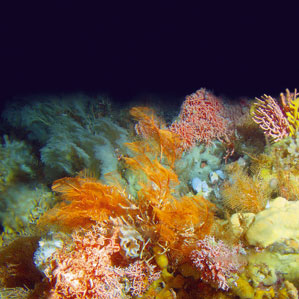
ALBERTO LIDNER / NOAAJust beneath the surface: Stylasteridae coral found in the Aleutian Islands, AlaskaALBERTO LIDNER / NOAA
From 2001 to 2003, biologist Alberto Lindner, from the State of Santa Catarina, was lucky to go where many people would never dream of going. He sailed through the icy waters of the Bering Sea in Alaska, close to the North Pole, and then crossed the warm, sunny waters of New Caledonia in the South Pacific, close to Australia and New Zealand. This was not a vacation. He was interested in collecting as many examples as possible of a group of corals, of varied shapes and bright colors, which are rarely found along the Brazilian coast: more specifically, he was looking for coral from the Stylasteridae family, found almost exclusively in deep ocean waters.
On board a research ship, Lindner gathered coral that had been caught up in fishing nets, brought in by dredges scraping the bottom of the sea, or collected with the help of small submarines. He gathered more than 3 thousand samples of 100 of the 250 identified species of the Stylasteridae, the second smallest of the four known coral families. These corals, which range in size from a few centimeters to nearly one meter, actually comprise a colony with millions of invertebrate animals with a very simple body, formed by a mouth surrounded by tentacles and a single cavity that is both a stomach and an intestine.
During his work for the doctoral program that he attended in the United States under the sponsorship of Capes and of the United States’ National Science Foundation, Lindner compared his samples of corals with other samples collected in different regions of the planet. He noticed that the collected Stylasteridae included 26 species that science had yet to describe. These corals are in the shape of lettuce head or a bush, with carmine, yellow or orange pigments – microscopic algae called zooxantelles determine the color in other groups. They belong to the Stylaster, Lepidopora, Lepidotheca, Distichopora and Stephanohelia species and were found at depths ranging from 100 to 1.000 meters, in regions which might possibly have coral reefs, limestone mounds covered with living coral, comprising one of the environments with the widest diversity of species in the world; this environment is currently threatened by human activities, such as fishing, and climate change.
The blue waters of the Pacific Ocean also provided clearer evidence of how marine life evolved and spread throughout the oceans in the last 65 million years. Together with Clifford Cunningham, from Duke University, and Stephen Cairns, from the United States’ National History Museum, Lindner analyzed three genes of the coral samples on loan from the museums and that he had collected in Alaska, New Caledonia and in the West Coast of the United States. He established the degree of kinship among the one hundred Stylasteridae species. By cross-checking his information with information on coral fossils collected around the world, Lindner and the American biologists rebuilt the evolutionary history of this family, which first appeared 65 million years ago when the continents were located in positions similar to their current locations.
What does this story tell? Of course, it tells a lot about the past of these corals. But it also contributes to update and complement a theory proposed nearly 130 years ago to explain the evolution of marine life. In 1880, British naturalist Henry Nottidge Moseley, who was part of the ocean-going expedition on the Challenger, published an article in Nature, arguing that the species that inhabit the continents and the oceans nowadays first appeared in shallow seas and later on spread out to the deeper, less stormy regions. Recently, biologists David Jacobs and David Lindberg, from the University of California in Los Angeles, United States, obtained chemical evidence that corroborates this idea: between 240 million and 90 million years ago, the level of oxygen in the depths of the primitive seas diminished to the point of making the existence of animals unfeasible.
Against the current
When the oxygen in the water increased, marine animals from the shallow waters spread out into deeper waters. The Stylasteridae corals did the opposite, according to the work of Lindner. They appeared 65 million years ago in regions located hundreds of meters below the surface and during at least four distinct times, they invaded the coastal regions. On three occasions, at least, (approximately 30 million, 15 million and 10 million years ago) they migrated to the tropical seas and approximately 20 million year ago, they arrived in the shallow waters of the temperate zone. “This result does not invalidate Moseley’s hypothesis, according to which tropical shallow waters functioned as a reservoir of marine diversity”, says Lindner. “But it shows that the contrary probably happened as well”.
Lindner’s work also indicates that deep waters are not always calm, which is why, according to geologist Geerat Vermeij, from the University of California at Davis, many species exchanged shallow waters for marine valleys (66% of the 5,080 species of coral live below 50 meters). Three species of Adelopora coral, which have a stony structure over the opening of the mouth to protect them from the attacks of marine slugs and snails, come from deep waters, according to the article in PLoS One. “This protection mechanism suggests that there is considerable predator pressure on the organisms that live in deep waters”, says Lindner, who is currently enrolled in a post-doctoral program at the Marine Biology Center, the University of São Paulo, on the São Paulo coast, where he implemented a molecular biology lab with the support of FAPESP and the CNPq, Brazil’s National Scientific and Technological Development Council. “We still know very little about the ecology of animals that live in deep waters”, says Lindner, who recently started to investigate the evolution of the antomedusae, a group of marine animals that includes other groups of coral, jellyfish and hydrozoa.
Republish
